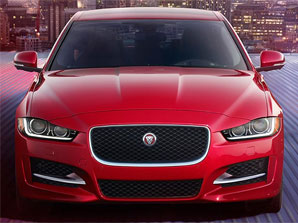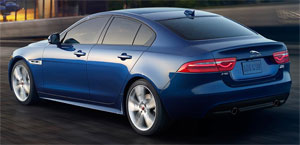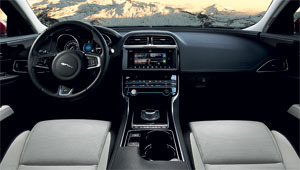2017 Jaguar XE
The last Jaguar compact sports sedan we tested was the X-type. Don’t remember it? Well, that’s probably a good thing, as that Ford Contour based front-driver never made a serious impact here, or anywhere else for that matter. Just too much a parts bin car. Now, Jag is stepping back into that segment, and stepping up, with what may be a much more impactful car. This is the XE.
After first hitting European streets a year ago, the 2017 Jaguar XE sedan now makes its way to America’s potholes, looking to catch a ride on Jaguar’s recent Big Kahuna size wave of sales success.
And, awaiting you inside this compact sport 4-door, is the familiar Jaguar theme of late, along with plenty of the accustomed switchgear.
And that’s great. But, the drab and unappealing space it fits into is not. Much of the dash real estate goes unused. There is nothing for the passenger to look at except lots of pebbled plastic and a big airbag logo.
The XE really needs some extra trim to brighten up the space, and reinforce its upscale kinship to other Jaguars, and frankly, look competitive to other rear-drive European sport-luxury sedans.
Now that that’s out of the way, we’ll get to what we love about the XE; and there’s plenty of it. Starting with what’s under the hood.
 Here, its Jaguar’s lovely 3.0-liter supercharged V6; boasting 340-horsepower and 332 lb-ft. of torque. A 2.0-liter diesel is also available. Both are equipped with an 8-speed automatic transmission, and you can get all-wheel-drive with both.
Here, its Jaguar’s lovely 3.0-liter supercharged V6; boasting 340-horsepower and 332 lb-ft. of torque. A 2.0-liter diesel is also available. Both are equipped with an 8-speed automatic transmission, and you can get all-wheel-drive with both.
A rear-drive only, gasoline-fed 2.0-liter I4 model is offered as well.
At the track, our rear drive V6 did do some battle with wheel spin at launch, but then got off to a very nice 4.9-second 0-60. Power never deviates, with enough midrange torque for days; or at least for a 13.5–second 1/4-mile at 105 miles-per-hour. Lovely!
Automatic shifts are quick and seamless; all accompanied by a subtle exhaust note reminiscent of, but nowhere near as fierce as, the F-type.
It was easy to keep the speed up through our handling course. If we didn’t already know that steering was electric, we’d have a hard time guessing; very responsive, if down on true road feel.
Dynamic mode tightens and quickens everything up, helping to improve feel; though we found throttle response now touchy, and it was easy to initiate too much oversteer.
A 112-foot average stopping distance from 60, is quite good; as was pedal feel and overall stability.
 On public roads, near posted speeds, the XE drives wonderfully. It’s a highly capable back road blaster, with a tremendously smooth and placid nature.
On public roads, near posted speeds, the XE drives wonderfully. It’s a highly capable back road blaster, with a tremendously smooth and placid nature.
The ZF-sourced 8-speed transmission is well-sorted, and also well-matched to this V6; we only experienced some occasion jerkiness in stop-and-go traffic.
With every setting at its sportiest, the XE does a decent 3-series impression, but it feels more at home kept in softer settings.
Compared to rivals such as the 3-Series, C-Class, A4, and ATS; the XE is far more gorgeous to look at.
The proportions look just right, there are enough creases and angles to keep it interesting, and the coupe-like, thick C-pillar profile is certainly consistent with the segment. So, any compromise to rear visibility is a concession we can live with.
Like most recent Jag’s, there are plenty of stylish details that remind us of the now haloed F-type.
Plenty of tech features are available too, and you can activate the rear camera almost any time; which we feel is a better solution than Cadillac’s rearview mirror cam.
 And while some may think we were a bit harsh in our earlier description of the XE’s overall interior environment; we have only praise for Jag’s latest InControl touch system that manages it. It’s logical, and responds quickly to your inputs. A huge step up!
And while some may think we were a bit harsh in our earlier description of the XE’s overall interior environment; we have only praise for Jag’s latest InControl touch system that manages it. It’s logical, and responds quickly to your inputs. A huge step up!
A host of advanced safety systems are available for ’17, including autonomous braking; but our tester wasn’t so-equipped.
Government Fuel Economy Ratings for a V6 rear driver are 21-City, 30-Highway, and 24-Combined. Our average was a better than expected 25.8 mile-per Premium gallon. That’s an Energy Impact Score of 13.7-barrels of annual oil consumption with CO2 emissions of 6.1-tons.
XE pricing starts very reasonably at $35,895 for a turbo-4 25t; and the V6 35t is not out of line either, at $42,695; with the diesel falling in between the two.
The 2017 Jaguar XE continues the brand’s streak of all-around performance winners. Plus, on the outside, it’s very easy on the eyes. But, it’s going up against a sea of excellent alternatives with a lackluster interior that is no help. Still, and very much unlike the X-type before it, there’s a lot to like and admire about the XE, and it clearly deserves to be part of any luxo-sport sedan conversation.
Specifications
- Engine: 3.0 liter
- Horsepower: 340
- Torque: 332 lb-ft.
- 0-60 mph: 4.9 seconds
- 1/4 mile: 13.5 seconds @ 105 mph
- EPA: 21 mpg city / 30 mpg highway
- Energy Impact: 13.7 barrels of oil/yr
- CO2 Emissions: 6.1 tons/yr
2024 Polestar 2
More Range And More Power For The Polestar 2
Volvo is well on their way to making the transition to an all-electric brand, but their sister-brand Polestar is already there. Now, we’ve spent lots of time in their all-wheel drive, five-door Polestar 2, having tested it in 2021, and a year later when a two-wheel drive version arrived. But, EV updates are coming quickly. So, let us be your guide for all that’s new with the Polestar 2.
While we are driving more EVs than ever, we’ve also been spending a lot of time recently circling back to ones we’ve previously tested. As in this new era of electrified vehicles, significant updates are arriving quickly, with R&D investments increasing and retrofitting them easier than ever. This is often done through software updates that can even be accomplished over the air. For 2024, the Polestar 2 has indeed gotten some software updates, but some physical ones as well.
Clearly aimed directly at Tesla’s Model 3 when it arrived; the Polestar 2’s build quality was vastly better, but range definitely came up short. So, addressing that was priority No. 1; and for ’24 the Polestar can travel up to 20% farther than before while consuming 9% less energy, and when it comes time to charge it back up, it can do that 34% faster too.
Range in the Single Motor version increases from a max of 270 to 320 miles thanks to a larger 82-kWh battery pack, and that solitary motor now powers the rear wheels, not the front wheels. It’s also bigger, coming in at 220 kW compared to the previous 170 kW front-wheel drive version, going from 231 to 299 horsepower.
Dual Motors keep the same 78-kWh battery, but still sees a boost from 260 to 276 miles and takes advantage of the larger rear motor for a new combined 310-kW output with 421 horsepower. Our test car has the added Performance Pack, which uses an additional 35 kW to deliver 455 horsepower and 546 lb-ft of torque, though max range drops to just 247 miles.
The new battery in rear-drive 2s will also charge faster, now accepting up to 205 kW for an 80% charge in 20 minutes; max for dual-motors stays at 155 kW, which puts an 80% charge at 34 minutes. Using 32 kWh of electricity per 100 miles, the Dual Motor earns a good efficiency rating.
The [Polestar] 2 has always been one of the most enjoyable EVs to drive, even more so now with that additional power coming from the rear motor.
Unfortunately, extremely cold temperatures kept us from seeing that increased range, as we were only on pace for about 194 miles in our test.
The 2 has always been one of the most enjoyable EVs to drive, even more so now with that additional power coming from the rear motor. And especially when equipped with the Performance Pack as it not only includes more power, but adds 20-inch forged wheels, upgraded brakes, and adjustable Ohlins Dual Flow Valve performance dampers. It greatly improves handling prowess without affecting ride quality, and is easily worth the $5,500 charge if you at all enjoy driving.
Even on a 20-degree track day there was plenty of grip through our handling course. No understeer or oversteer, and lots of feedback through the wheel. There was a nice, strong launch off the line that properly planted us firmly in the seat, and rocketed us to 60 in 4.5 seconds. Power delivery stayed pretty intense up until about 80 mph when there was a definite tapering off. Still, it was a 13.4-second quarter-mile at 102 mph; smooth, quiet, and stable the whole way.
When this car debuted, its Google-based infotainment setup was a novelty, but since then, more and more manufacturers are just “Googling it” so it doesn’t seem out of place at all. The wireless phone charger is easy to access, and there’s a great Harmon/Kardon sound system and panoramic sunroof to enhance the in-cabin experience. Exteriors have also been enhanced with a smooth grille insert and new wheel choices.
Hatchback practicality means 14.3 cu-ft of easy to access cargo space with split-folding seatbacks for longer items and expanding the space to 38.7 cu-ft. Plus, there’s even a sizeable storage bin up front under the hood.
Single Motor Polestar 2 pricing now starts at $51,300, with Dual Motors starting at $56,700; topping out at $64,400.
For a car manufacturer that hasn’t even been around for a decade yet, Polestar has kept itself busy, totally transforming their latest model in just a few years, making the 2024 Polestar 2 even more appealing. They are certainly off to a good start, and with a host of Polestars just over the horizon, including some all-important utility vehicles, this star will be shining even brighter.
Specifications
As Tested
- Motor Setup: Dual Motor
- Horsepower: 455
- 0-60 mph: 4.5 seconds
- EPA Range: 247 miles
- Efficiency : 32 kWh / 100 miles
- Battery Size: 78-kWh
- Torque: 546 lb-ft
- 1/4 Mile: 13.4 seconds at 102 mph
- MW Test Loop: ~ 194 miles
- Peak Charging Rate: 155 kW











































